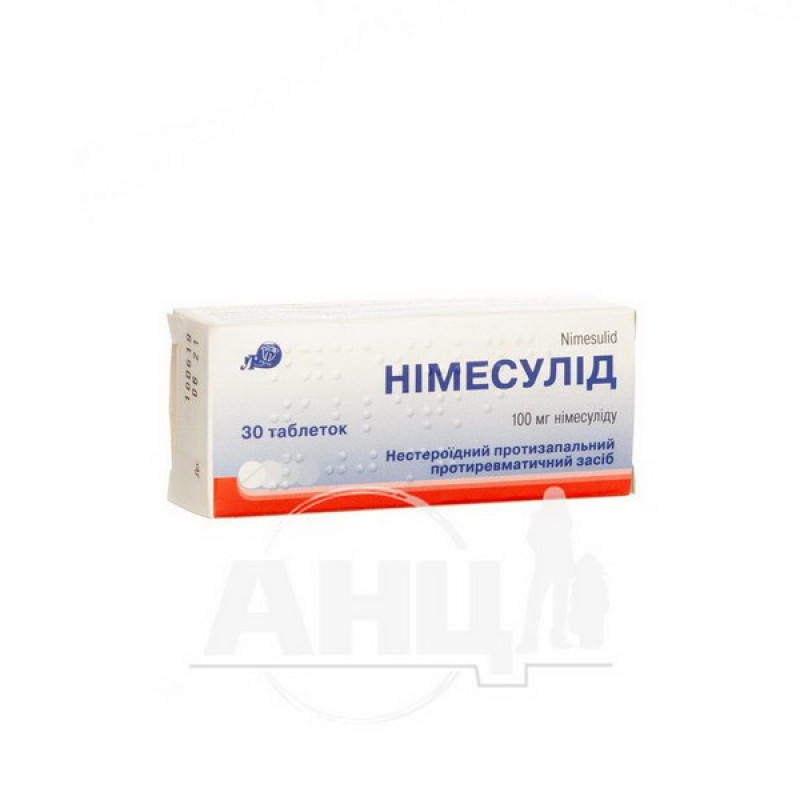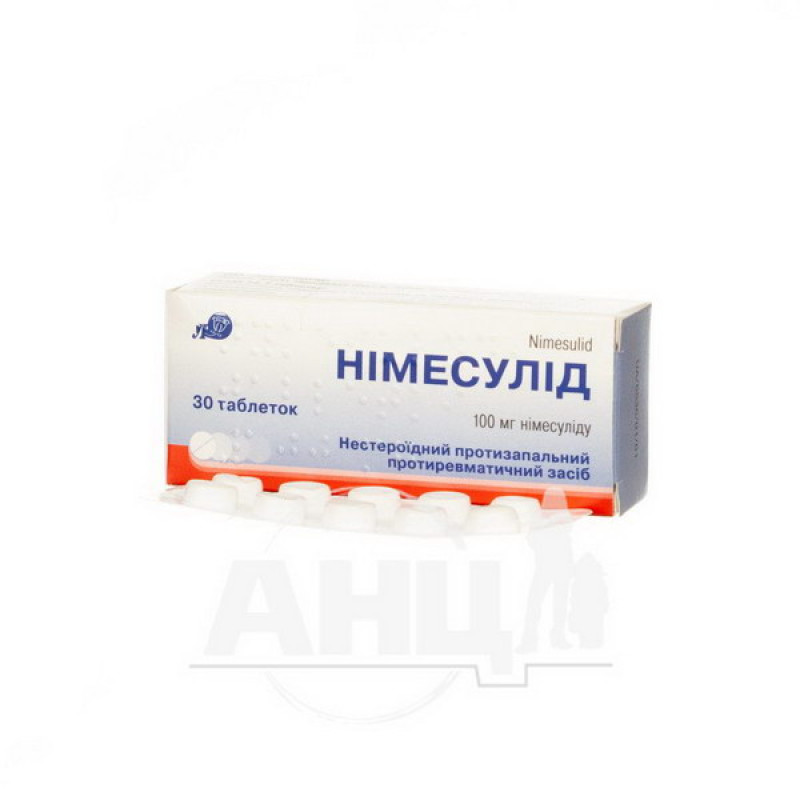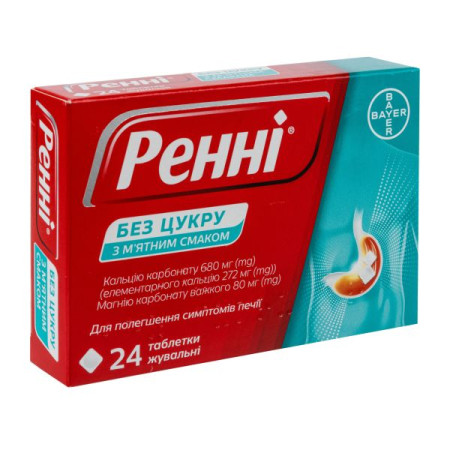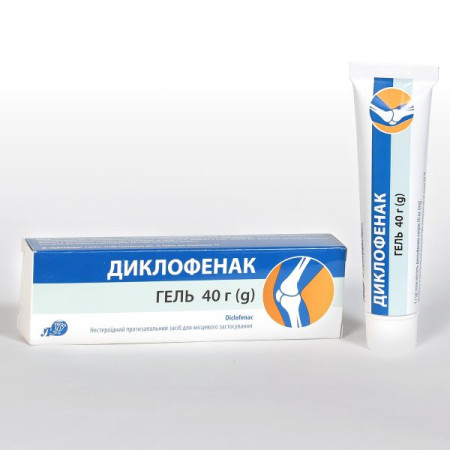Nimesulide tablets 100 mg blister No. 30

Translation of the instructions can be
Nimesulide tablets 100 mgInstruction
For medical use of the drug
Nimesulide
(Nimesulide)
Composition:
Active ingredient: nimesulide;
1 tablet contains nimesulide in terms of 100% dry matter 100 mg;
Excipients: lactose monohydrate; potato starch; microcrystalline cellulose; colloidal anhydrous silicon dioxide; calcium stearate.
Dosage form.
Pills.
Pharmacotherapeutic group.
Nonsteroidal anti-inflammatory and antirheumatic drugs.
PBX code M01A X17.
Clinical characteristics.
Indication.
Treatment of acute pain. Symptomatic treatment of osteoarthritis with pain syndrome. Primary dysmenorrhea.
Contraindication.
Known hypersensitivity to nimesulide or to any component of the drug. Hyperergic reactions that have occurred in the past (bronchospasm, rhinitis, urticaria) in connection with the use of acetylsalicylic acid or other non-steroidal anti-inflammatory drugs; hepatotoxic reactions to nimesulide that have occurred in the past; gastric and duodenal ulcers in the acute phase, recurrent ulcers or bleeding in the digestive tract, cerebrovascular bleeding or other lesions accompanied by bleeding; severe blood clotting disorders; severe heart failure; severe renal or hepatic failure; increased body temperature and flu-like symptoms, suspected acute surgical pathology. Do not use simultaneously with other drugs that can potentially cause hepatotoxic reactions. alcoholism and drug addiction.
Method of administration and doses.
Nimesulide is prescribed after a careful assessment of the benefit/risk ratio. Use the minimum effective dose for the shortest possible time. The maximum duration of treatment with nimesulide is 15 days.
Adults and the elderly: 1 tablet (100 mg) 2 times a day (daily dose - 200 mg).
Children over 12 years of age: no dose adjustment is required.
Patients with renal impairment: For patients with mild or moderate renal impairment (creatinine clearance 30-80 ml/min), no dose adjustment is required. The drug should be taken orally after meals with sufficient fluid.
Adverse reactions.
The frequency of adverse events is classified as follows: very common (1/10), common (1/100, 1/1000, 1/10,000,
From the blood system: rarely - anemia, eosinophilia; very rarely - thrombocytopenia, pancytopenia, purpura.
On the part of the immune system: rarely - hypersensitivity; very rarely - anaphylaxis.
Metabolic disorders: rarely - hyperkalemia.
On the part of the psyche: rarely - a feeling of fear, nervousness, nightmares.
From the nervous system: sometimes - dizziness; very rarely - headache, drowsiness, encephalopathy (Reye's syndrome).
On the part of the organs of vision: rarely - blurred vision.
On the part of the organs of hearing: very rarely - vertigo (dizziness).
From the cardiovascular system: rarely - tachycardia, hemorrhage, lability of blood pressure, hot flashes; sometimes - arterial hypertension.
From the respiratory system: sometimes - shortness of breath; very rarely - asthma, bronchospasm.
Gastrointestinal tract: often - diarrhea, nausea, vomiting; sometimes - constipation, flatulence, gastritis; very rarely - abdominal pain, dyspepsia, stomatitis, black stools, bleeding in the digestive tract, ulcer and perforation of the duodenum / stomach.
From the hepatobiliary system: very rarely - hepatitis, fulminant hepatitis with fatal outcome, jaundice, cholestasis.
On the part of the skin: sometimes - itching, skin rashes, increased sweating; rarely - erythema, dermatitis; very rarely - urticaria, angioedema, facial edema, erythema multiforme, Stevens-Johnson syndrome, toxic epidermal necrolysis.
From the urinary system: rarely - dysuria, hematuria, urinary retention; very rarely - renal failure, oliguria, interstitial nephritis.
General disorders: sometimes - edema; rarely - malaise, asthenia; very rarely - hypothermia.
Laboratory indicators: often - increased levels of liver enzymes.
Overdose.
Use during pregnancy or breastfeeding.
The use of nimesulide may increase female fertility and is not recommended for women who are planning to become pregnant. Nimesulide is not recommended for women who have difficulty conceiving or who are undergoing investigation for infertility.
The use of Nimesulide is contraindicated in the third trimester of pregnancy.
Like other nonsteroidal anti-inflammatory drugs, Nimesulide is not recommended for use in women planning to become pregnant.
Like other nonsteroidal anti-inflammatory drugs that inhibit prostaglandin synthesis, nimesulide can cause premature closure of the ductus arteriosus, pulmonary hypertension, oliguria, oligohydramnios. The risk of bleeding, labor weakness and peripheral edema increases. There are isolated reports of renal failure in newborns born to women who used nimesulide late in pregnancy.
The drug is not used in the first and second trimesters of pregnancy.
Since it is not known whether nimesulide is excreted in breast milk, its use during breastfeeding is not recommended.
Children.
Nimesulide is not used in children under 12 years of age.
Application features.
Undesirable side effects can be minimized by taking the lowest effective dose for the shortest period of use necessary to control the symptoms of the disease. In the absence of treatment effectiveness (reduction of symptoms of the disease), therapy with the drug should be discontinued. There have been reports of cases of severe liver reactions, including fatal ones, when using nimesulide. Patients who have symptoms similar to symptoms of liver damage during treatment with nimesulide, for example, anorexia, nausea, vomiting, abdominal pain, fatigue, dark urine, or patients whose laboratory liver function tests differ from normal values, should discontinue use of the drug. Re-administration of nimesulide to such patients is contraindicated. During treatment with nimesulide, the use of other analgesics should be avoided. Concomitant use of other NSAIDs, including selective cyclooxygenase-2 inhibitors, should be avoided. Patients who have used nimesulide and who have symptoms similar to flu or cold should stop using it. Elderly patients have an increased frequency of adverse reactions to NSAIDs, especially possible bleeding and perforation in the digestive tract, which can be fatal for the patient. Ulcer, bleeding or perforation in the digestive tract can threaten the life of the patient, especially if there is evidence in the anamnesis that similar phenomena have occurred in the patient when using any other NSAIDs (without a prescription). The risk of such phenomena increases with increasing NSAID dose, in patients with a history of ulcer in the digestive tract, especially complicated by bleeding or perforation, as well as in elderly patients. Treatment of such patients should be started with the lowest possible effective dose. For these patients, as well as for those who are taking concomitant low doses of acetylsalicylic acid or other drugs that increase the risk of gastrointestinal complications, combination therapy with drugs such as misoprostol or proton pump inhibitors should be considered. Patients with toxic gastrointestinal lesions, especially the elderly, should be informed of any unusual symptoms occurring in the gastrointestinal tract, especially bleeding. This is especially important in the initial stages of treatment. Patients taking concomitant drugs that may increase the risk of ulceration or bleeding, such as corticosteroids, anticoagulants, selective serotonin reuptake inhibitors, antiplatelet agents (acetylsalicylic acid), should be informed of the need to exercise caution when using nimesulide. In the event of bleeding or ulceration of the gastrointestinal tract in patients receiving nimesulide, treatment with the drug should be discontinued. NSAIDs should be prescribed with caution to patients with a history of Crohn's disease or ulcerative colitis, as nimesulide may exacerbate them. Patients with a history of hypertension and/or heart failure, as well as patients with fluid retention and edema due to NSAID use, require appropriate monitoring and consultation with a doctor. Clinical studies and epidemiological data suggest that some NSAIDs, especially in high doses and with prolonged use, may lead to a small risk of arterial thrombotic episodes, such as myocardial infarction and stroke. There is insufficient data to exclude the risk of such events when using nimesulide. Patients with uncontrolled hypertension, acute heart failure, established ischemic heart disease, peripheral artery disease and/or cerebrovascular disease should be prescribed nimesulide after careful assessment of the condition. It is also necessary to carefully assess the condition of patients with risk factors for cardiovascular disease, for example, with arterial hypertension, hyperlipidemia, diabetes mellitus, smoking, before prescribing the drug. The drug should be prescribed with caution to patients with renal or heart failure due to possible deterioration of renal function. In case of deterioration of the condition, treatment should be discontinued. Elderly patients should be carefully monitored due to the possible occurrence of bleeding and perforation of the digestive tract, deterioration of renal, hepatic or cardiac function. Since nimesulide can affect platelet function, it should be prescribed with caution to patients with hemorrhagic diathesis. However, nimesulide does not replace acetylsalicylic acid in the prevention of cardiovascular disease. Nimesulide should be discontinued at the first signs of skin rash, damage to the mucous membranes and other manifestations of an allergic reaction.
In the event of an increase in body temperature or the appearance of flu-like symptoms in patients using nimesulide, the drug should be discontinued.
The effect of nimesulide on the ability to drive and perform work requiring increased attention has not been studied. However, patients who experience dizziness or drowsiness after using nimesulide should refrain from driving and performing work requiring increased attention.
Interaction with other drugs and other types of interactions.
Pharmacodynamic interactions.
Corticosteroids: Increased risk of gastrointestinal ulceration or bleeding.
Antiplatelet agents and selective serotonin reuptake inhibitors (SSRIs): increased risk of gastrointestinal bleeding.
Anticoagulants: NSAIDs may enhance the effects of anticoagulants such as warfarin or acetylsalicylic acid, so this combination is not recommended or contraindicated in patients with severe coagulation disorders. If such combination therapy cannot be avoided, careful monitoring of blood coagulation parameters is necessary.
Diuretics, angiotensin-converting enzyme inhibitors and angiotensin II antagonists: NSAIDs may reduce the effect of diuretics and other antihypertensive drugs. In some patients with impaired renal function (e.g. dehydrated patients or the elderly), the combined use of ACE inhibitors, angiotensin II antagonists or agents that inhibit the cyclooxygenase system may lead to further deterioration of renal function and the development of acute renal failure, which is usually reversible. These interactions should be taken into account when the patient uses Nimesulide together with ACE inhibitors or angiotensin II antagonists. Great caution should be exercised when using such a combination, especially in the elderly. Patients should receive sufficient fluids, and renal function should be closely monitored after the start of such a combination. Nimesulide temporarily reduces the effect of furosemide on sodium excretion, to a lesser extent on potassium excretion and reduces the diuretic effect. The simultaneous use of furosemide and Nimesulide requires caution in patients with impaired renal or cardiac function.
Pharmacokinetic interactions with other drugs.
There have been reports that NSAIDs reduce lithium clearance, leading to increased plasma lithium levels and lithium toxicity. When prescribing Nimesulide to patients receiving lithium therapy, frequent monitoring of plasma lithium levels is required.
There is no clinically significant interaction with glibenclamide, theophylline, warfarin, digoxin, cimetidine and antacids (aluminum and magnesium hydroxide combination). Nimesulide inhibits the activity of the 2C9 enzyme. When used simultaneously with Nimesulide, drugs that are substrates of this enzyme may increase their plasma concentration. Caution is required when nimesulide is prescribed less than 24 hours before or less than 24 hours after taking methotrexate, since an increase in the level of the latter in the blood serum and an increase in its toxicity is possible.
Pharmacological properties.
Pharmacodynamics.
Nimesulide is a nonsteroidal anti-inflammatory drug of the methanesulfonanilide group, which has anti-inflammatory, analgesic and antipyretic effects. The therapeutic effect of Nimesulide is due to the fact that it interacts with the arachidonic acid cascade and reduces the biosynthesis of prostaglandins by inhibiting cyclooxygenase.
Pharmacokinetics.
In the human body, nimesulide is well absorbed after oral administration, reaching a maximum concentration in plasma after 2-3 hours. Up to 97.5% of nimesulide binds to plasma proteins. Nimesulide is actively metabolized in the liver with the participation of CYP2C9, an isoenzyme of cytochrome P450. The main metabolite is parahydroxyproizvodnoe, which also has pharmacological activity. The half-life is from 3.2 to 6 hours. Nimesulide is excreted from the body with urine - about 50% of the dose taken. About 29% of the dose taken is excreted with feces in a metabolized form. Only 1-3% is excreted from the body unchanged. The pharmacokinetic profile in the elderly does not change.
Pharmaceutical characteristics.
Main physical and chemical properties: solid, regular, round cylinders, the upper and lower surfaces of which are flat, the edges of the surfaces are beveled, without a dividing line, light yellow in color, marbling on the surface is allowed.
Expiration date.
2 years.
Storage conditions.
Store in the original packaging at a temperature not exceeding 25 °C.
Keep out of reach of children.
Packaging.
10 tablets in a blister.
10 tablets in blisters, 3 blisters in a cardboard pack.
Vacation category.
According to the recipe.
Producer.
Lubnypharm PJSC.
Location.
Ukraine, 37500, Poltava region, M lubny, Barvinkova st., 16.
There are no reviews for this product.
There are no reviews for this product, be the first to leave your review.
No questions about this product, be the first and ask your question.










